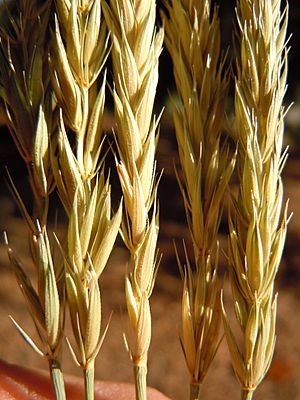Russian wildrye facts for kids
Quick facts for kids Russian wildrye |
|
|---|---|
 |
|
| Scientific classification | |
| Genus: |
Psathyrostachys
|
| Species: |
juncea
|
| Synonyms | |
|
Elymus junceus Fisch. |
|
Russian wildrye (scientific name: Psathyrostachys juncea) is a type of grass. It used to be called Elymus junceus. This grass originally comes from Russia and China. It has also been brought to other places like Canada and the United States.
Russian wildrye is a great food source for animals that eat grass, like cows and sheep. Its thick leaves at the bottom of the plant are very nutritious, even in late summer and autumn. This grass can grow well in tough environments. This makes it a good plant to improve for farming in areas where it's hard to grow other crops. It can handle dry weather and cold seasons. It also needs pollen from another plant to make seeds, which helps keep its genes diverse.
Contents
What is Russian Wildrye?
Russian wildrye is a bunch grass that lives for many years. It grows in clumps that can be up to 1 meter (about 3 feet) tall or even taller. This grass can live a long time, sometimes more than 25 years when grown by farmers.
Roots and Leaves
Each clump of grass has a thick network of roots underground. It does not spread with rhizomes or stolons (underground or above-ground stems that spread new plants). Its roots can grow very deep, up to 3 meters (about 10 feet) into the soil.
The leaves grow mostly around the bottom of the stems. They can be straight or curly. Old leaf coverings become stringy. The inflorescence (the part with flowers and seeds) is a spike that can be 11 to 16 centimeters (about 4 to 6 inches) long.
Special Types of Russian Wildrye
Scientists have created many special types, called cultivars, of Russian wildrye. Some well-known ones are 'Vinall', 'Bozoisky-Select', and 'Bozoisky II'.
How Russian Wildrye Grows From Seed
Even though Russian wildrye can survive tough conditions, it can be tricky to plant at first. The seeds need just the right conditions to start growing. Young Russian wildrye plants are not very strong when they first sprout. However, once they start growing, they can handle most harsh weather.
Scientists are looking for ways to help more seeds sprout successfully. One idea is to increase the plant's "ploidy." This means changing the number of sets of chromosomes in its cells. Normally, Russian wildrye plants have two sets of chromosomes (diploid). But plants with four sets (tetraploid) have bigger seeds and stronger young plants. Scientists can now easily make Russian wildrye tetraploid. This helps farmers grow more successful crops.
Scientists have also studied what makes more seeds grow. Plants with more strong stems, more flowers per cluster, and heavier seeds tend to produce more seeds overall. This information helps improve how Russian wildrye is grown. Also, less water and more nitrogen fertilizer can make the plant's leaves and flowers healthier, leading to a better harvest.
Why is Russian Wildrye Useful?
Russian wildrye was brought to North America to be used as forage (food for animals) and to help fix up rangelands and stop soil from washing away. It is considered one of the best grasses for dry pastures.
Food for Animals
Animals like livestock (cows, horses) and wild animals like elk enjoy eating Russian wildrye. However, it's not the best for making hay because most of its leaves are at the bottom. It grows especially well when planted in rows with a legume plant, like alfalfa.
Protecting the Land
This grass usually does not spread out of control and become a noxious weed. It rarely grows outside the areas where it was planted. However, in some parts of the Southwestern United States, like on the Grand Canyon plateaus, it has spread more widely.
Russian wildrye is very tough. It can handle dry weather, most floods, and cold temperatures. It also grows well in soil that has a lot of salt.
Surviving Tough Conditions
It's hard to get Russian wildrye to grow from seeds. If the seeds are planted deeper than 1.9 centimeters (about 0.75 inches), not many young plants will sprout. The young plants are weak. But once the grass is established, it is very strong. It competes well for water and nutrients. It can even survive fires because its thick clumps of stems protect the parts that can grow new shoots after a fire.
How Russian Wildrye is Related to Wheat
Scientists have found special proteins in Russian wildrye that are similar to those in wheat. These proteins help determine how much wheat quality can be improved in a plant. Studying these proteins helps scientists understand how different Triticeae species (a group that includes wheat) are related.
This means Russian wildrye is closely related to wild wheat plants. Because of this, scientists think Russian wildrye could help improve wheat. If wheat quality can be improved, Russian wildrye might even become a crop for people to eat, especially in dry areas where it's hard to grow other foods. The main challenge right now is that it's very difficult to cross-pollinate wheat and Russian wildrye because their reproductive cells are not compatible.

